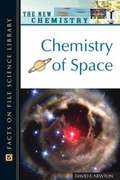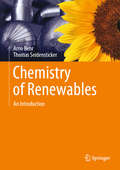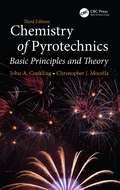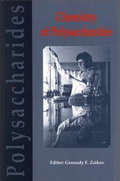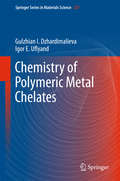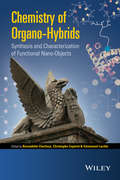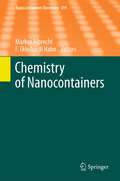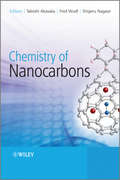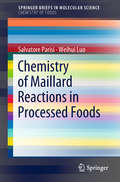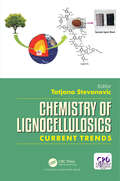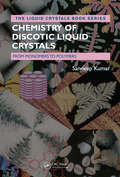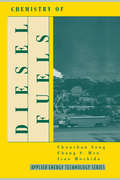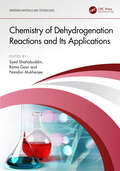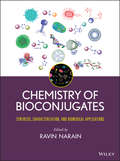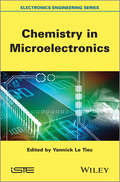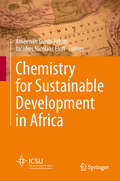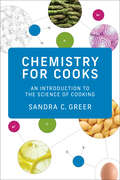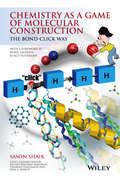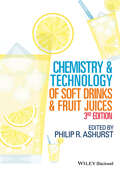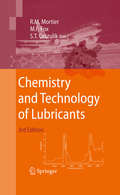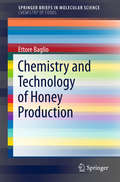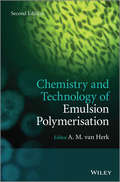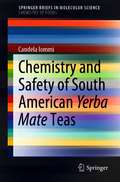- Table View
- List View
Chemistry of Space
by David E. NewtonChemistry of Space provides an overview of the latest information about the solar system, comets, and meteors, and other features of the universe made available as a result of space exploration and research in astrochemistry. The volume is an impressive account of our universe, the events through which it was created, the changes that have taken place during its evolution, and its present composition.
Chemistry of Renewables: An Introduction
by Arno Behr Thomas SeidenstickerThis textbook introduces the industrial production and processing of natural resources. It is divided into six major topics (fats and oils, carbohydrates, lignin, terpenoids, other natural products, biorefinery), which are divided into a total of 20 chapters.Each chapter is self-contained and therefore a compact learning unit, which can be worked on by students in self-study or presented by lecturers. Clear illustrations, flow diagrams, apparatus drawings and photos facilitate the understanding of the subject matter. All chapters end with a succinct summary, the "Take Home Messages". Each chapter is supplemented by ten short test questions, which can be solved quickly after working through the chapter; the answers are at the end of the book. All chapters contain bibliographical references that focus on essential textbooks and reference works. As a prior knowledge, only basic knowledge of chemistry is required.
Chemistry of Pyrotechnics: Basic Principles and Theory, Third Edition
by Chris Mocella John A. ConklingThis book provides chemists with technical insight on pyrotechnics and explosives. It emphasizes basic chemical principles and practical, hands-on knowledge in the preparation of energetic materials. It examines the interactions between and adaptations of pyrotechnics to changing technology in areas such as obscuration science and low-signature flame emission. The updated third edition discusses chemical and pyrotechnic principles, components of high-energy materials, elements of ignition, propagation, and sensitivity. It offers heat compositions, including ignition mixes, delays, thermites, and propellants and investigates the production of smoke and sound as well as light and color.
Chemistry of Polysaccharides
by Gennady E. ZaikovThis monograph summarizes scientific achievements in the field of polysaccharide chemistry performed in the last decade. The book is intended for wide range of readers: students, post graduates, engineers and scientists engaged in polymer chemistry, organic and physical chemistry.
Chemistry of Polymeric Metal Chelates
by Gulzhian I. Dzhardimalieva Igor E. UflyandThis book deals with the chemistry of polymeric metal chelates. The main results and the production and chemical structure of polymers with chelate units as well as the specificity of metal complex binding of different structure are presented here. This book also reveals the transformations which components undergo in the course of chelation. Special attention is paid not only to synthetic but also to natural (including living) systems. The usage of polymeric metal chelates and their development are examined. The related research was performed for chelates with chain structure. This book is useful to researchers being active in synthesis and design of macromolecular metal chelates
Chemistry of Organo-hybrids
by Christophe Coperet Bernadette Charleux Emmanuel LacoteThis book provides readers with a one-stop entry into thechemistry of varied hybrids and applications, from a molecularsynthetic standpoint* Describes introduction and effect of organicstructures on specific support components (carbon-based materials,proteins, metals, and polymers).* Chapters cover hot topics including nanodiamonds,nanocrystals, metal-organic frameworks, peptide bioconjugates, andchemoselective protein modification* Describes analytical techniques, with pros and cons,to validate synthetic strategies* Edited by internationally-recognized chemists fromdifferent backgrounds (synthetic polymer chemistry, inorganicsurfaces and particles, and synthetic organic chemistry) to pulltogether diverse perspectives and approaches
Chemistry of Nanocontainers (Topics in Current Chemistry #319)
by Markus Albrecht F. Ekkehardt HahnMolecular Cages and Capsules with Functionalized Inner Surfaces, by Stefan Kubik. Drug Delivery by Water-Soluble Organ metallic Cages, by Bruno Therrien. Reversibly Expanded Encapsulation Complexes, by Dariush Ajami und Julius Rebek. Container Molecules Based on Imine Type Ligands, by A. Carina Schulze und Iris M. Oppel. Molecular Capsules Derived from Resorcin[4]arenes by Metal-Coordination, by Tobias Schröder, Satya Narayan Sahu und Jochen Mattay. Coronates, Spherical Containers, Bowl-Shaped Surfaces, Porous 1D-, 2D-, 3D-Metallo-Coordination Polymers, and Metallodendrimers, by Rolf W. Saalfrank und Andreas Scheurer.
Chemistry of Nanocarbons
by Fred Wudl Shigeru Nagase Takeshi AkasakaDuring the last decade, fullerenes and carbon nanotubes have attracted special interest as new nanocarbons with novel properties. Because of their hollow caged structure, they can be used as containers for atoms and molecules, and nanotubes can be used as miniature test-tubes.Chemistry of Nanocarbons presents the most up-to-date research on chemical aspects of nanometer-sized forms of carbon, with emphasis on fullerenes, nanotubes and nanohorns. All modern chemical aspects are mentioned, including noncovalent interactions, supramolecular assembly, dendrimers, nanocomposites, chirality, nanodevices, host-guest interactions, endohedral fullerenes, magnetic resonance imaging, nanodiamond particles and graphene. The book covers experimental and theoretical aspects of nanocarbons, as well as their uses and potential applications, ranging from molecular electronics to biology and medicine.
Chemistry of Maillard Reactions in Processed Foods (Springerbriefs In Molecular Science)
by Salvatore Parisi Weihui LuoThis SpringerBrief explains the importance of Maillard reactions in food processing. It underlines that the term “Maillard reaction” actually does not describe one single chemical reaction, but an entire class of chemical reactions, which lead to browning, with a strong impact on visual appearance, odor, and flavor. It emphasizes that the Maillard reactions are still not fully characterized, despite extensive historical studies. While under the right conditions Maillard reactions have many favorable effects (e.g. formation of antioxidants), the Brief discusses that there are also conditions where Maillard reactions can result in toxic or mutagenic reactions. Hence, it emphasizes that the reaction should be viewed as a complex network of various sub-reactions, with a plethora of concomitant reaction mechanisms and kinetics. This Brief thus makes a step toward a holistic evaluation of the complexity of the Maillard reaction scheme, with the aim of making better and more targeted use in food processing.
Chemistry of Lignocellulosics: Current Trends
by Tatjana StevanovicThis book presents the chemical properties of lignocellulosic fibers, knowledge of which is essential for innovation and sustainable development of their transformation. Thermochemical transformation of wood and other lignocellulosics is presented to highlight its volatile, liquid and solid products and their novel applications. Forest biorefinery is described to emphasize the new products from lignocellulosic constituents, both structural (cellulose, hemicelluloses and lignins) and those extraneous to cell walls-extractives. New developments in cellulose technology related to nanocellulose are discussed in relation to new applications. Industrial lignins are presented in detail, both in terms of extraction procedures from spent liquors and structural characterization of the isolated lignins. Application of lignocellulosic biopolymers in new composite materials, or in biomaterials for medicinal purposes, and in solid wood preservation, are described. The example of an industrial biorefinery installed in southwestern France more than 40 years ago is presented.
Chemistry of Hazardous Materials
by Eugene MeyerChemistry of Hazardous Materials, Sixth Edition, covers basic chemistry for emergency responders, guiding students who are often non-science majors through the process of understanding the chemical properties that make materials hazardous. This text covers many essential hazardous materials topics, such as the Globally Harmonized System of Classification and Labeling of Chemical Substances (GHS); terrorist threats relative to biological, chemical, and radioactive agents; and the latest best practices for the handling and storage of hazardous materials. This new edition continues to emphasize the hazardous materials regulations established by the OSHA, the U.S. D.O.T., and the EPA.
Chemistry of Fossil Fuels and Biofuels
by Harold SchobertFocusing on today's major fuel resources – ethanol, biodiesel, wood, natural gas, petroleum products and coal – this book discusses the formation, composition and properties of the fuels, and the ways in which they are processed for commercial use. It examines the origin of fuels through natural processes such as photosynthesis and the geological transformation of ancient plant material; the relationships between their composition, molecular structures and physical properties; and the various processes by which they are converted or refined into the fuel products appearing on today's market. Fundamental chemical aspects such as catalysis and the behaviour of reactive intermediates are presented and global warming and anthropogenic carbon dioxide emissions are also discussed. The book is ideal for graduate students in energy engineering, chemical engineering, mechanical engineering and chemistry, as well as professional scientists and engineers.
Chemistry of Discotic Liquid Crystals: From Monomers to Polymers (Liquid Crystals Book Series)
by Sandeep KumarThe self-contained properties of discotic liquid crystals (DLCs) render them powerful functional materials for many semiconducting device applications and models for energy and charge migration in self-organized dynamic functional soft materials. The past three decades have seen tremendous interest in this area, fueled primarily by the possibility
Chemistry of Diesel Fuels
by Chunsham SongThis edited work covers diesel fuel chemistry in a systematic fashion from initial fuel production to the tail pipe exhaust. The chapters are written by leading experts in the research areas of analytical characterization of diesel fuel, fuel production and refining, catalysis in fuel processing, pollution minimization and control, and diesel fuel additives.
Chemistry of Dehydrogenation Reactions and Its Applications (Emerging Materials and Technologies)
by Nandini Mukherjee Syed Shahabuddin Rama GaurThe present book focuses on advancement in the application of heterogeneous catalytic materials for the dehydrogenative synthesis of valuable organic compounds from substrates such as alcohols and simple aliphatic compounds. Several heterogeneous transition metals-based catalytic materials are explored for the synthesis of valuable chemicals for industrial applications. The book provides insight into the application of state-of-the-art technology for energy utilization and clean chemical synthesis. Features: Offers a wide overview of dehydrogenation catalytic chemistry catalyzed by transition metals and their compounds. Helps design novel and more benign and uncomplicated protocols for the synthesis of valuable chemicals from readily available raw materials. Provides deeper insight into the aspect of dehydrogenation reactions for clean chemical synthesis via a cascade process. Summarizes new mechanistic details of dehydrogenation reactions, experimental side development and applications of dehydrogenation techniques. Explores alternative solutions for the assimilation and transportation of clean energy in the form of hydrogen energy utilization. This book is aimed at graduate students and researchers in chemical engineering, chemistry, catalysis, organic synthesis, pharmaceutical chemistry and petrochemistry.
Chemistry of Bioconjugates
by Ravin NarainExplores bioconjugate properties and applications of polymers, dendrimers, lipids, nanoparticles, and nanotubesBioconjugation has enabled breakthroughs across many areas of industry and biomedicine. With its emphasis on synthesis, properties and applications, this book enables readers to understand the connection between chemistry and the biological application of bioconjugated materials. Its detailed descriptions of methods make it possible for researchers to fabricate and take full advantage of bioconjugates for a broad range of applications. Moreover, the book sets the foundation for the development of new applications, including assays, imaging, biosensors, drug delivery, and diagnostics.Chemistry of Bioconjugates features contributions from an international team of leading experts and pioneers in the field. These contributions reflect the authors' firsthand laboratory experience as well as a thorough review of the current literature. The book's six sections examine:General methods of bioconjugationPolymer bioconjugatesOrganic nanoparticle-based bioconjugatesInorganic nanomaterial bioconjugates, including metals and metal oxidesCell-based, hydrogel/microgel, and glyco-bioconjugatesCharacterization, physico-(bio)chemical properties, and applications of bioconjugatesThis comprehensive exploration of bioconjugates includes discussions of polymers, dendrimers, lipids, nanoparticles, and nanotubes. References at the end of each chapter serve as a gateway to the most important original research findings and reviews in the field.By drawing together and analyzing all the latest chemical methods and research findings on the physico-chemical and biochemical properties of bioconjugates, Chemistry of Bioconjugates sheds new light on the significance and potential of bioconjugation. The book is recommended for organic and polymer chemists, biochemists, biomaterial scientists, carbohydrate chemists, biophysicists, bioengineers, and drug and gene delivery scientists.
Chemistry in Microelectronics
by Yannick Le TiecMicroelectronics is a complex world where many sciences need to collaborate to create nano-objects: we need expertise in electronics, microelectronics, physics, optics and mechanics also crossing into chemistry, electrochemistry, as well as biology, biochemistry and medicine. Chemistry is involved in many fields from materials, chemicals, gases, liquids or salts, the basics of reactions and equilibrium, to the optimized cleaning of surfaces and selective etching of specific layers. In addition, over recent decades, the size of the transistors has been drastically reduced while the functionality of circuits has increased. This book consists of five chapters covering the chemicals and sequences used in processing, from cleaning to etching, the role and impact of their purity, along with the materials used in “Front End Of the Line” which corresponds to the heart and performance of individual transistors, then moving on to the “Back End Of the Line” which is related to the interconnection of all the transistors. Finally, the need for specific functionalization also requires key knowledge on surface treatments and chemical management to allow new applications. Contents 1. Chemistry in the “Front End of the Line” (FEOL): Deposits, Gate Stacks, Epitaxy and Contacts, François Martin, Jean-Michel Hartmann, Véronique Carron and Yannick Le Tiec. 2. Chemistry in Interconnects, Vincent Jousseaume, Paul-Henri Haumesser, Carole Pernel, Jeffery Butterbaugh, Sylvain Maîtrejean and Didier Louis. 3. The Chemistry of Wet Surface Preparation: Cleaning, Etching and Drying, Yannick Le Tiec and Martin Knotter. 4. The Use and Management of Chemical Fluids in Microelectronics, Christiane Gottschalk, Kevin Mclaughlin, Julie Cren, Catherine Peyne and Patrick Valenti. 5. Surface Functionalization for Micro- and Nanosystems: Application to Biosensors, Antoine Hoang, Gilles Marchand, Guillaume Nonglaton, Isabelle Texier-Nogues and Francoise Vinet. About the Authors Yannick Le Tiec is a technical expert at CEA-Leti, Minatec since 2002. He is a CEA-Leti assignee at IBM, Albany (NY) to develop the advanced 14 nm CMOS node and the FDSOI technology. He held different technical positions from the advanced 300 mm SOI CMOS pilot line to different assignments within SOITEC for advanced wafer development and later within INES to optimize solar cell ramp-up and yield. He has been part of the ITRS Front End technical working group at ITRS since 2008.
Chemistry for Sustainable Development in Africa
by Ameenah Gurib-Fakim Jacobus Nicolaas EloffChemistry for Sustainable Development in Africa gives an insight into current Chemical research in Africa. It is edited and written by distinguished African scientists and includes contributions from Chemists from Northern, Southern, Western, Eastern, Central and Island state African Countries. The core themes embrace the most pressing issues of our time, including Environmental Chemistry, Renewable Energies, Health and Human Well-Being, Food and Nutrition, and Bioprospecting and Commercial Development. This book is invaluable for teaching and research institutes in Africa and worldwide, private sector entities dealing with natural products from Africa, as well as policy and decision-making bodies and non-governmental organizations.
Chemistry for Cooks: An Introduction to the Science of Cooking
by Sandra C. GreerA fun approach to teaching science that uses cooking to demonstrate principles of chemistry for undergraduate students who are not science majors, high school students, culinary students, and home cooks.How does an armload of groceries turn into a culinary masterpiece? In this highly accessible and informative text, Sandra C. Greer takes students into the kitchen to show how chemistry—with a dash of biology and physics—explains what happens when we cook. Chemistry for Cooks provides all the background material necessary for nonscientists to understand essential chemical processes and to see cooking as an enjoyable application of science. Greer uses a variety of practical examples, including recipes, to instruct readers on the molecular structure of food, the chemical reactions used in cooking to change the nature of food, and the essentials of nutrition and taste. She also offers kitchen hints and exercises based on the material in each chapter, plus do-it-yourself projects to encourage exploration of the chemistry that takes place when we cook food. FeaturesPerfect for science courses aimed at non–science majors: does not require prior knowledge of chemistry, physics, or biologyEqually useful for general readers, home and professional cooks, and culinary studentsTopics include what matter is made of, how the structure of matter is altered by heat, how we treat food in order to change its microscopic structure, why particular procedures or methods are used in the kitchen, and how to think critically about various cooking methodsA reference section at the end of each chapter points readers to resources for further studyAdditional online resources include a solutions manual, a sample syllabus, and PowerPoint slides of all tables and figures
Chemistry as a Game of Molecular Construction
by Roald Hoffmann Sason Shaik Racheli Ben-Knaz Wakshlak Dina A. Sharon Usharani DandamudiThe proposed textbook takes the students into a fascinating journey that shows the universal aspect of chemistry: Chemistry is the window given to mankind to glimpse into his material-chemical essence and come to terms with its limitations. In the introductory chapter/lecture, the textbook discusses the connection between the "chemical matter" and love, sex, depression, addiction--all the properties we call "human". As we are made of chemical matter, this chapter makes a point why knowledge of chemistry is so essential to mankind. This preamble is followed by about 14 short chapters/lectures, which introduce chemistry as molecule building process, like a game of Lego.
Chemistry and Technology of Soft Drinks and Fruit Juices
by Philip R. AshurstSoft drinks and fruit juices are produced in almost every country in the world and their availability is remarkable. From the largest cities to some of the remotest villages, soft drinks are available in a variety of flavours and packaging. Over the last decade, soft drinks and fruit juices have been the subject of criticism by the health community and there is considerable pressure on beverage manufacturers to reduce, or even remove, the sugar content of these products. Chemistry and Technology of Soft Drinks and Fruit Juices, Third Edition provides an overview of the chemistry and technology of soft drinks and fruit juices, covering ingredients, processing, microbiology, traceability and packaging as well as global market trends. This fully revised edition now includes chapters on topics that have become prominent in the industry since publication of the previous edition namely: water use and treatment, and microbiology technologies. The book is directed at graduates in food science, chemistry or microbiology entering production, quality control, new product development or marketing in the beverage industry or in companies supplying ingredients or packaging materials to the beverage industry.
Chemistry and Technology of Lubricants
by Malcolm F. Fox Stefan T. Orszulik Roy M. Mortier"Chemistry and Technology of Lubricants" describes the chemistry and technology of base oils, additives and applications of liquid lubricants. This Third Edition reflects how the chemistry and technology of lubricants has developed since the First Edition was published in 1992. The acceleration of performance development in the past 35 years has been as significant as in the previous century: Refinery processes have become more precise in defining the physical and chemical properties of higher quality mineral base oils. New and existing additives have improved performance through enhanced understanding of their action. Specification and testing of lubricants has become more focused and rigorous. "Chemistry and Technology of Lubricants" is directed principally at those working in the lubricants industry as well as individuals working within academia seeking a chemist's viewpoint of lubrication. It is also of value to engineers and technologists requiring a more fundamental understanding of the subject.
Chemistry and Technology of Honey Production (SpringerBriefs in Molecular Science)
by Ettore BaglioThis Brief explains and discusses honey and its production from a chemical perspective. It outlines why honey is a special and unique food, being produced by bees from the nectar of plants or from secretions of living parts of plants. Although glucose and fructose are the main constituents of honey, its overall composition is far from being simple or uniform: other substances such as organic acids, enzymes, or minerals are found in varying amounts. In this Brief, the author addresses the factors that influence the composition of the honey as well as the consequences that the composition has on properties such as color, crystallization, density, viscosity, or the refractive index. This Brief also introduces some of the most commonly used quality parameters for the determination of ageing and/or overheating: 5-hydroxymethylfurfural (HMF) and diastase. Other recently proposed constituents for quality parameters are also mentioned, e. g. 1,2 dicarbonyl compounds (3 deoxyglucosone, methylglyoxal, glyoxal) and furosine, also named 2-furoylmethyl lysine.
Chemistry and Technology of Emulsion Polymerisation
by A. M. van HerkChemistry and Technology of Emulsion Polymerisation 2e provides a practical and intuitive explanation of emulsion polymerization, in combination with both conventional and controlled radical polymerization. For those working in industry, coupling theory with everyday practice can be difficult. By carefully explaining the principles of the reaction, based on well-designed experimental investigation, the book explains how the principles relate to practical application.The second edition of this book includes a new chapter on morphology of latex particles, a rapidly progressing area where modelling the thermodynamic and kinetic aspects of phase separation and morphology has developed into a mature and powerful tool to predict and control morphology of latex particles. Another area that is rapidly progressing is the application of controlled radical polymerisation in emulsion polymerization. Controlled radical polymerisation is used in aiding encapsulation of inorganic particles like pigment particles and clay platelets. These latest developments are included in the second edition.
Chemistry and Safety of South American Yerba Mate Teas (SpringerBriefs in Molecular Science)
by Candela IommiThis book explores the traditional use of Ilex paraguariensis, a plant that is widely distributed in South America. Thanks to its purported properties, it has been used for centuries in the form of teas with a variety of names, including: ‘yerba mate’ (Argentina), ‘chimarrão’ (Brazil), and others. Ilex paraguariensis and its teas (also referred to as ‘mate teas’) are well known because of their alleged pharmacological effects in numerous common conditions, including obesity, osteoporosis, constipation, arthritis, and hypertension. These effects are generally ascribed to yerba mate teas because the botanical species contains bioactive and stimulating substances like caffeine (originally dubbed ‘mateine’), various alkaloids, and several phenolic acids. Interestingly, the chemical profiles of these teas can fluctuate over time, creating serious production problems. As a result, it is difficult to reliably determine their safety and health effects on humans. In response to the global interest in these products, this book offers a reference guide to ‘yerba mate’/‘chimarrão’ teas. It analyzes their chemical profiles, discusses their bioactive features, and addresses their safety and health effects. In addition, since the cultural heritage of yerba mate has greatly contributed to its international success, the book also provides information on its historical legacy, regulatory aspects, and the global market.
